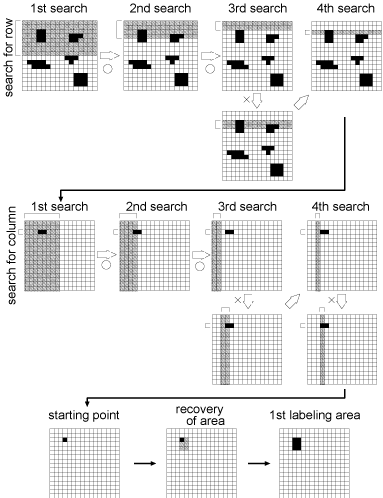Multi-target Tracking Algorithm
Summary
We propose a multi-target tracking algorithm utilizing the unique features of our vision chip, such as the high-frame rate and pixel parallel operation. These features allow the algorithm simplified, thus realizing high-speed processing. The input images for this algorithm are assumed to be binary.
The multi-target tracking algorithm consists of a labeling process and a tracking process. Labeling is the initial process to generate new targets, and tracking is the process to carry out regional division and matching of each target between frames.
As the labeling algorithm, we use a method using binary search of an entire image. Binary search enables efficient labeling. Moreover, this labeling method is executed at high-speed by using pixel parallel operation. Fig.1 shows the flow of this labeling algorithm.

Fig. 1: Labeling algorithm using binary search
New tracking target regions are generated by the labeling process. Then, after initializing the frame, the tracking process is applied. We use a previously proposed method for high-speed vision, Self-Windowing, to match the target regions between frames in the tracking process. Fig. 2 shows an outline of the tracking process. We apply this multi-target tracking to real-time visual measurement.

Fig. 2: Multi-target Tracking
References
- Yoshihiro Watanabe, Takashi Komuro, Shingo Kagami, Masatoshi Ishikawa: Multi-Target Tracking Using a Vision Chip and its Applications to Real-Time Visual Measurement, Journal of Robotics and Mechatronics, Vol. 17, No. 2 , pp. 121-129, 2005. [PDF]
- Yoshihiro Watanabe, Takashi Komuro, Shingo Kagami, Masatoshi Ishikawa: Real-time Visual Measurements using High-speed Vision, Optics East (Philadelphia 2004.10.28) / Machine Vision and its Optomechatronic Applications, Proceedings of SPIE Vol. 5603, pp. 234-242. [PDF]



